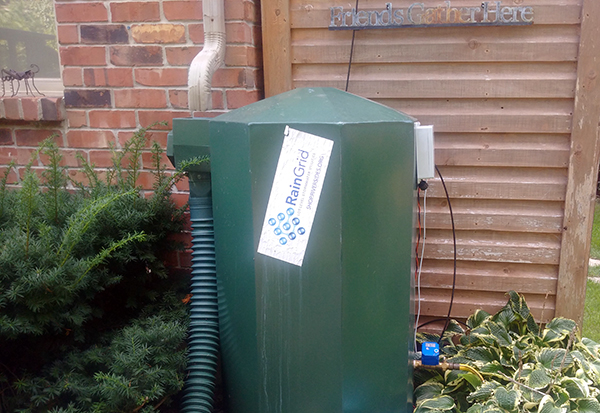Toronto RainCAP Pilot Project
Organization: RiverSides Foundation
Location:
Toronto, ON M4K 1W6
Riverdale neighborhood, located east of the Don River ravine.
Country: Canada
Other Organizations Involved:
- RainGrid Inc.
- City of Toronto, Economic Development Office, GMAP

Background
The collection, management and treatment of urban storm water continue to be longstanding challenges facing aquatic ecosystems, municipal governments and the residents they serve. Often, after storms, rainwater runoff from roofs and impermeable surfaces finds its way to the sewers. Approximately 35% of that urban runoff is from roofs. Because storm water runoff and sanitary sewers are only partially separated, often this rainwater mixes with sewage and overflows to ravines and streams or is directly discharged (untreated) from the treatment plant to the lake.
This can cause:
- Basement flooding and foundation infiltration, resulting in increased insurance costs and decreased coverage for residents and businesses.
- Contamination of stream and lake ecosystems with sewage and surface runoff, causing the closing of beaches and impaired recreational use.
- The need for expanded capital outlay to build expensive belowground storage and treatment capacity, demanding construction and excavation in urban communities.
In addition, climate change is manifesting in storms that occur more frequently and with more intensity. Unfortunately, conventional solutions, like separating sanitary sewers and creating new belowground storage options are expensive to taxpayers, disruptive to residents and local businesses, and time-consuming to plan and construct.
In the past, many municipal rain barrel programs, although widespread, have proved largely ineffective. Standard residential rain barrels distributed through municipal programs or commercially available to homeowners are too small to cope with the capacity needed. In addition, rain barrels are often not emptied. Thus, they are inadequate or unprepared to capture storm water runoff when they are most needed. The RainCAP Pilot is designed to solve these persistent issues by automating the control of the rain barrel, maximizing collection capacity and collecting comprehensive data sets.
Goals
The goals of this project are to:
- Demonstrate, measure and identify the economic and environmental benefits of real-time, automated storm water management systems.
- Engage the Riverdale community for participation and expansion.
- Reduce storm water discharges to local sewers and streams.
Main activities
This project will:
- Engage community and partnerships to build support and participation.
- Install and run automated RainGrid in 15 Riverdale households.
- Publish and promote Toronto RainCAP pilot results.
Results
The desired outcomes from this project are as follows:
- Build constituency of support for automated rain barrels and residential storm water management.
- Recruit, Install and demonstrate the RainGrid technology in 15 Riverdale households.
- Collect data on real-time residential storm water management by 15 householders. Including total rainwater diverted from sewer, total used for residential use.
- Build community and municipal support for expansion to 100 residents and other communities.
- Final report documenting results, lessons and potential.